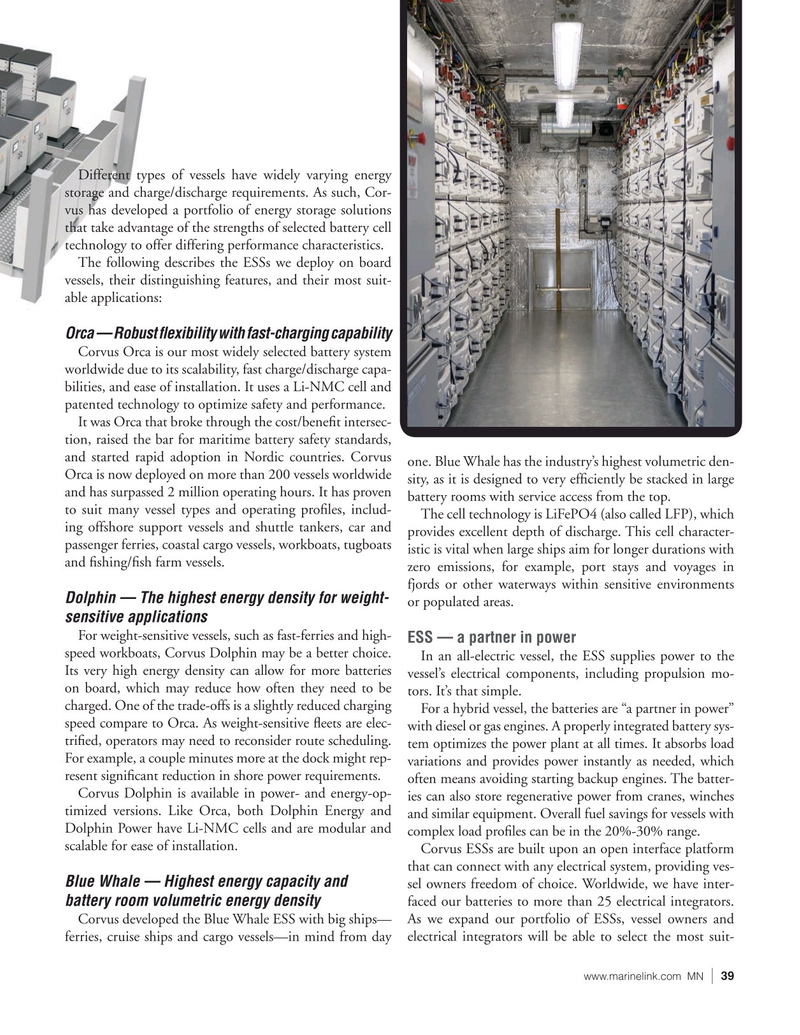
Page 39: of Marine News Magazine (January 2021)
Passenger Vessels
Read this page in Pdf, Flash or Html5 edition of January 2021 Marine News Magazine
Different types of vessels have widely varying energy storage and charge/discharge requirements. As such, Cor- vus has developed a portfolio of energy storage solutions that take advantage of the strengths of selected battery cell technology to offer differing performance characteristics.
The following describes the ESSs we deploy on board vessels, their distinguishing features, and their most suit- able applications:
Orca — Robust ? exibility with fast-charging capability
Corvus Orca is our most widely selected battery system worldwide due to its scalability, fast charge/discharge capa- bilities, and ease of installation. It uses a Li-NMC cell and patented technology to optimize safety and performance.
It was Orca that broke through the cost/bene? t intersec- tion, raised the bar for maritime battery safety standards, and started rapid adoption in Nordic countries. Corvus one. Blue Whale has the industry’s highest volumetric den-
Orca is now deployed on more than 200 vessels worldwide sity, as it is designed to very ef? ciently be stacked in large and has surpassed 2 million operating hours. It has proven battery rooms with service access from the top.
to suit many vessel types and operating pro? les, includ-
The cell technology is LiFePO4 (also called LFP), which ing offshore support vessels and shuttle tankers, car and provides excellent depth of discharge. This cell character- passenger ferries, coastal cargo vessels, workboats, tugboats istic is vital when large ships aim for longer durations with and ? shing/? sh farm vessels.
zero emissions, for example, port stays and voyages in fjords or other waterways within sensitive environments
Dolphin — The highest energy density for weight- or populated areas.
sensitive applications
For weight-sensitive vessels, such as fast-ferries and high-
ESS — a partner in power speed workboats, Corvus Dolphin may be a better choice.
In an all-electric vessel, the ESS supplies power to the
Its very high energy density can allow for more batteries vessel’s electrical components, including propulsion mo- on board, which may reduce how often they need to be tors. It’s that simple.
charged. One of the trade-offs is a slightly reduced charging
For a hybrid vessel, the batteries are “a partner in power” speed compare to Orca. As weight-sensitive ? eets are elec- with diesel or gas engines. A properly integrated battery sys- tri? ed, operators may need to reconsider route scheduling. tem optimizes the power plant at all times. It absorbs load
For example, a couple minutes more at the dock might rep- variations and provides power instantly as needed, which resent signi? cant reduction in shore power requirements.
often means avoiding starting backup engines. The batter-
Corvus Dolphin is available in power- and energy-op- ies can also store regenerative power from cranes, winches timized versions. Like Orca, both Dolphin Energy and and similar equipment. Overall fuel savings for vessels with
Dolphin Power have Li-NMC cells and are modular and complex load pro? les can be in the 20%-30% range.
scalable for ease of installation.
Corvus ESSs are built upon an open interface platform that can connect with any electrical system, providing ves-
Blue Whale — Highest energy capacity and sel owners freedom of choice. Worldwide, we have inter- faced our batteries to more than 25 electrical integrators. battery room volumetric energy density
Corvus developed the Blue Whale ESS with big ships— As we expand our portfolio of ESSs, vessel owners and ferries, cruise ships and cargo vessels—in mind from day electrical integrators will be able to select the most suit- www.marinelink.com MN 39|

 38
38

 40
40
